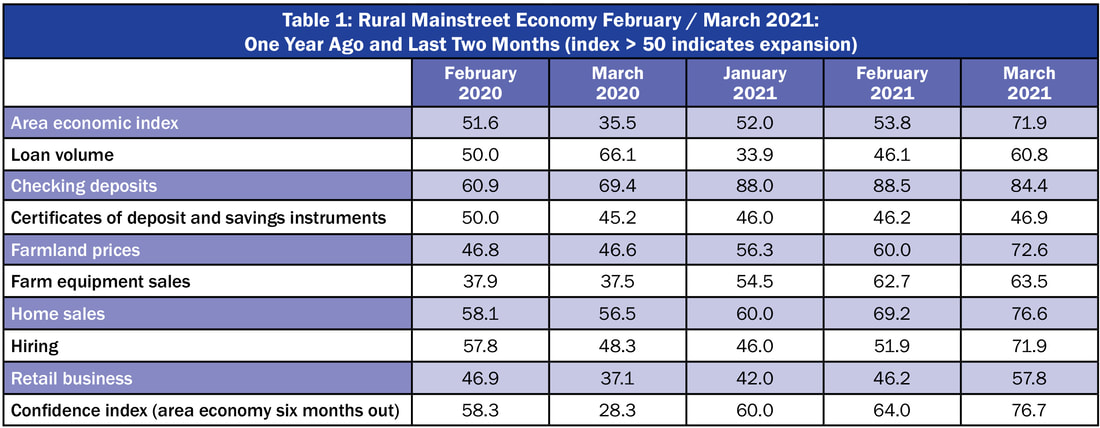- Overall index rose to its highest reading since January 2020.
- Business and economic outlook soared to its highest level since March 2011.
- Bank CEOs estimated 2021 cash land rent for non-irrigated, non-pastureland at $218.
- Rural Mainstreet retail sales remain very weak.
- The February farmland price index climbed to its highest level since May 2013.
- Bankers expect farm equipment sales to expand by 3.8% over the next 12 months.
OMAHA, Neb. (Feb. 18, 2021) – For the fourth time in the past five months, the Creighton University Rural Mainstreet Index (RMI) climbed above growth neutral. According to the monthly survey of bank CEOs in rural areas of a 10-state region dependent on agriculture and/or energy, the index increased to its highest level since January 2020.
Overall: The overall index for February rose to 53.8 from January’s 52.0. The index ranges between 0 and 100 with a reading of 50.0 representing growth neutral.
“Sharp gains in grain prices, federal farm support, and the Federal Reserve’s record-low interest rates have underpinned the Rural Mainstreet Economy. Only 8% of bank CEOs indicated economic conditions worsened from the previous month. Even so, current rural economic activity remains below pre-pandemic levels,” said Ernie Goss, PhD, Jack A. MacAllister Chair in Regional Economics at Creighton University’s Heider College of Business.
Bank CEOs estimated 2021 cash land rent for non-irrigated, non-pastureland at $218.
The February farm equipment-sales index rose to 62.7, its highest reading since February 2013, and up from 54.5 in January. After 86 straight months of readings below growth neutral, farm equipment bounced into growth territory for the last three months.
“As a result of the rapidly improving farm economy, bankers expect farm equipment sales to expand by 3.8% over the next 12 months. This is up significantly from October when bank CEOs estimated that farm equipment sales would fall by an additional 3.1% over the same period,” said Goss.
Banking: Bankers once again reported anemic loan volumes. The February loan volume index increased to a weak 46.1 from January’s 33.9. The checking-deposit index soared to record high 88.5 from January’s 88.0, while the index for certificates of deposit, and other savings instruments increased to 46.2 from 46.0 in January.
Hiring: The new hiring index climbed to 51.9 from January’s 46.0. Data from the U.S. Bureau of Labor Statistics indicate that nonfarm employment levels for the Rural Mainstreet economy are down by 146,000 (nonseasonally adjusted), or 3.3%, compared to pre-COVID-19 levels, and down by 236,000, or 5.3%, from 12 months earlier.
“It will take many months of above growth neutral readings to get back to pre-COVID-19 employment levels for the region,” said Goss.
Confidence: The confidence index, which reflects bank CEO expectations for the economy six months out, rose to a very healthy 64.0, its highest level since March 2011, and up from January’s 60.0. “Federal farm support payments, improving gain prices, and advancing exports have supported confidence offsetting negatives from pandemic ravaged retail and leisure and hospitality companies in rural areas,” said Goss.
Home and Retail Sales: The home-sales index climbed to 69.2 from 60.0 in January. The retail-sales index for February increased to a frail 46.2 from 42.0 in January. “On-line buying and business closures linked to COVID-19 continue to harm the region’s retailers,” said Goss.
This survey represents an early snapshot of the economy of rural agriculturally and energy-dependent portions of the nation. The Rural Mainstreet Index (RMI) is a unique index covering 10 regional states, focusing on approximately 200 rural communities with an average population of 1,300. It gives the most current real-time analysis of the rural economy. Goss and Bill McQuillan, former chairman of the Independent Community Banks of America, created the monthly economic survey in 2005. Below are the state reports:
| Colorado: Colorado’s Rural Mainstreet Index (RMI) for February fell to 35.6 from January’s 41.6. The farmland and ranchland-price index dipped to 50.9 from 51.1 in January. Colorado’s hiring index for February rose to 43.8 from January’s 41.8. Over the past 12 months, Colorado’s Rural Mainstreet economy has lost 10.2% of its nonfarm employment compared to a 4.6% loss for urban areas of the state. Illinois: The February RMI for Illinois advanced to 52.8 from 50.6 in January. The farmland-price index advanced to 59.4 from January’s 55.6. The state’s new-hiring index climbed to 52.3 from 46.3 in January. Over the past 12 months, Illinois’ Rural Mainstreet economy has lost 5.5% of its nonfarm employment compared to a 7.2% loss for urban areas of the state. Iowa: The February RMI for Iowa increased to 54.0 from January’s 51.2. Iowa’s farmland-price index rose to 60.1 from 55.9 in January. Iowa’s new-hiring index for February advanced to 53.0 from 46.6 in January. Over the past 12 months, Iowa’s Rural Mainstreet economy has lost 4.1% of its nonfarm employment compared to a 4.2% loss for urban areas of the state. Kansas: The Kansas RMI for February increased to 55.9 from 53.6 in January. The state’s farmland-price index increased to 61.0 from January’s 57.1. The new-hiring index for Kansas climbed to 53.9 from 47.8 in January. Over the past 12 months, Kansas’ Rural Mainstreet economy has lost 3.9% of its nonfarm employment compared to a 4.2% loss for urban areas of the state. Minnesota: The February RMI for Minnesota rose slightly to 48.5 from January’s 48.0. Minnesota’s farmland-price index climbed to 57.3 from 54.3 in January. The new-hiring index for February jumped to 50.2 from 45.0 in January. Over the past 12 months, Minnesota’s Rural Mainstreet economy has lost 9.5% of its nonfarm employment compared to a 7.7% loss for urban areas of the state. | Missouri: The February RMI for Missouri climbed to a regional high 66.2 from January’s 63.6, also a regional high. The farmland-price index declined to 61.3 from January’s 62.1. The state’s hiring gauge soared to 59.1 from 49.1 in January. Over the past 12 months, Missouri’s Rural Mainstreet economy has experienced an increase in the size of its nonfarm employment by 1.9%, compared to a 3.6% loss for urban areas of the state. Nebraska: The Nebraska RMI for February expanded to 58.4 from January’s 55.6. The state’s farmland-price index climbed to 62.3 from last month’s 56.1. Nebraska’s new-hiring advanced to 55.2 from 45.4 in January. Over the past 12 months, Nebraska’s Rural Mainstreet economy has lost 2.4% of its nonfarm employment compared to a 2.2% loss for urban areas of the state. North Dakota: The North Dakota RMI for February increased to 41.2 from January’s 39.6. The state’s farmland-price index expanded to 53.7 from 50.1 in January. The state’s new-hiring index sank to 40.3 from January’s 42.1. Over the past 12 months, North Dakota’s Rural Mainstreet economy has lost 11.7% of its nonfarm employment compared to a 3.5% loss for urban areas of the state. South Dakota: The February RMI for South Dakota advanced to 59.6 from 58.4 in January. The state’s farmland-price index climbed to 62.9 from 59.5 in January. South Dakota’s February hiring index rose to 55.8 from 50.2 in January. Over the past 12 months, South Dakota’s Rural Mainstreet economy has lost 2.4% of its nonfarm employment compared to a 3.1% loss for urban areas of the state. Wyoming: The February RMI for Wyoming improved to 54.9 from January’s 51.4. The February farmland and ranchland-price index expanded to 60.5 from 56.0 in January. Wyoming’s new-hiring index slumped to 53.4 from January’s 56.7. Over the past 12 months, Wyoming’s Rural Mainstreet economy has lost 4.2% of its nonfarm employment compared to a 4.5% loss for urban areas of the state. |



 RSS Feed
RSS Feed